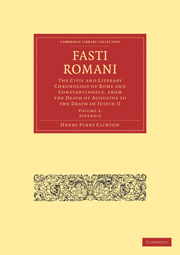 Fasti Romani
Fasti Romani Summary
THE BIRTH of Abraham is placed by Eusebius in October B. C. 2016. The years are computed from that point. In the following Table an expanded view is given of the first 104 years. In the obscure centuries that follow it is sufficient to mark the beginning of each century. But the thirteenth century contains the Olympic era, and in the following centuries the most important events of ancient history are registered down to the Christian era. From this last epoch the Eusebian years are every where quoted in the present Work, and this Table will exhibit them from the year 1201 to the end. The notation of the Armenian Copy is followed, which places the first Olympic games in the year 1240 and the Nativity in the close of the year 2015 in the 4th year of the 194th Olympiad. The Eusebian years commence in October; and as 1240 contained the beginning of Ol. 1. 1 July B. C. 776, it commenced in October B. C. 777. Ol. 194. 4 was the 776th Olympic year commencing in July B. C. 1. But, as the Eusebian year 1240 was still current when the first Olympic year began, then 1240 + 775 = 2015, and the 2015th year was still current when the 776th began. And as the year 1240 commenced in October preceding, or Oct. B. C. 777, so the year 2015 commenced in October preceding, or Oct. B. C. 2. These two epochs determine the position of the other years.
- Type
- Chapter
- Information
- Fasti RomaniThe Civil and Literary Chronology of Rome and Constantinople, from the Death of Augustus to the Death of Justin II, pp. 216 - 220Publisher: Cambridge University PressPrint publication year: 2010First published in: 1850


